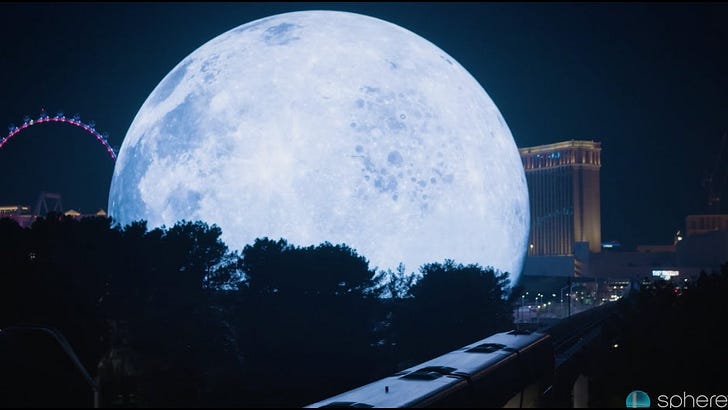061: More spectacular, please
Creativity at a Crossroads, Part 3 + the benefits of framing big "C" and little "c"
Here’s the final part. Two here. One here. Many thanks to my friends at Roundpeg for instigating the exploration and conversation.
This final creative crossroads is evergreen, and spans every medium. In short: Can you come up with an idea that transforms how we perceive our world?
I’m talking about spectacle.
The Sphere in Vegas, and any Meow Wolf installation clearly fit the bill. You can’t un-experience them. They stick with you long after, provoking reassessment. And yes, of course, these two examples require significant budget, large teams, long timeframes, and perspectives.
On the other hand we all remember ideas which were spectacular in their time and way, that never leave us. Or never leave me…
Ben Folds Chat Roulette Piano Improv
…we each have our own bookmarks.
And I’m hopeful what emerges from developers’ investment in spatial computing (and AR in general) might also create similar reactions.
The spatial computing creative brief
The firsts are so often polarizing, and rarely serve as the ultimate definition of a team’s intent or potential direction. The role of a first, I believe, is to begin a conversation. [You can see what Apple’s Vision Pro looks like in the context of your own space using their AR camera filter.
Unlike AI, which is and will be the permeating crossroad, or social which I think has become a significant, unavoidable creative crossroad, spectacle is absolutely optional. It has easy allure, but also serious requirements.
It’s not spectacle without significant risk
Spectacle is a dare.
Spectacle is rare.
Spectacle is, after all, attempting to transform how we perceive our world.
There can be too much spectacle.
With that in mind, I’m going to wrap up this series of observations on the State of Creativity by asserting two contrasting, but equal, organizing theories.
Little “c” and big “C” creativity serve as conversation starters; ways of enabling teams to set expectations and allocate resources. This work we’re about to begin… should we frame it within the confines of industrial creativity or the stereotype of artistic creativity?
1️⃣ In my mind, little “c” creativity is very, very predictable. There’s the old 80/10/20 marketing framework, where the 80% represents certainty—towards effort and allocation you know will return on investment. This is the realm of performance/direct marketing.
Which means 2️⃣ little “c” creative will absolutely benefit from generative AI because it’s largely predicated on known patterns. As we’ve witnessed, so much of the current, useful magic of generative AI is its ability to understand and build upon patterns. 3️⃣ Which means we can leverage AI to test, iterate and optimize to unearth more effective patterns, and continuously improve creative experiences.
4️⃣ Last but not least, little “c”—or industrial—creative helps include more people in creative expression that’s relevant, and on brand. I’m convinced the pandemic inaugurated more in-house, and remote team creativity. What AI and social platforms like Vimeo, or within Adobe’s suite, enable are “rules bound” creative expression. Imagine never having to worry about correct font or logo usage, brand color or image use accuracy, never mind image our audio licensing. Most employees are not art school graduates or even aware of the merits of design systems. Today’s industrial creative platforms ensure that’s not a problem.
If our goal is not to astonish, or overwhelm—but to inform, to guide, to assist, to nurture—then defining our work within little “c” definitions helps everyone stay on track, remain aligned, and focused on unsurprising outcomes.
By contrast…
There is a sentiment expressed in advertising circles which suggests “any” assignment can become spectacular. That banner ad, that sales sheet, that bit of SEO—just work all weekend to reframe strategy, budgets and expectations—and you will transform the world.
Maybe?
I’ve seen that reframing work a few times. Seems to boil down to relationships more than ideas. But let’s not forget the contrast.
1️⃣ Big “C” work will be unexpected, revolutionary, and full of pitfalls. Most people won’t like those circumstances. But here’s where we might leverage AI to research and reduce uncertainty, or social to test and confirm our assumptions.
2️⃣ Obviously big “C” creative is largely about spectacle. But, let’s be clear, this has more to do with intent than budget. Spectacle is an attitude more than a price tag. Meow Wolf delivers a lot of impact, for a much lower investment than the Sphere. And it all starts with intent.
3️⃣ In the grand scheme of things, big “C” creative likely starts very small, with ab appeal to the most passionate audiences. Again, this is where AI can help discern insights, and social can help reveal the weirdos who welcome distinct, fresh leaps.
And finally, 4️⃣ where little “c” is about managing and fueling creative consistency and creative craft, big “C” work isn’t familiar, because it’s opening unseen or locked doors, it’s trying to spark illumination where none existed before. And if we know, upfront, big “C” is our path, our objective—we can better manage expectations for the creativity which results.







